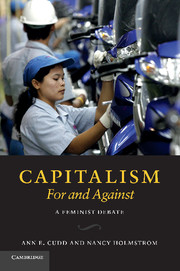1 - For capitalism as a feminist ideal and reality
Published online by Cambridge University Press: 05 June 2012
Summary
Introduction
A woman born in the late seventeenth century in Europe had a life expectancy of less than thirty years. She would have expected to bear seven children, and spend her days gathering wood and water, spinning yarn and making clothing, preparing food, and tending children. If she were born to a wealthy, aristocratic family she would have served mainly as a pawn in a diplomatic game between aristocratic families run by men and serving the interests of the oldest and most dominant among them. She did not look forward to any sort of political voice let alone power of her own unless she were one of the small handful of queens by birth. If she were born to a peasant family, she would have been illiterate. Much of her life was spent in hard labor and dirty, cramped conditions of life. She had little control over the timing or number of children she would bear, and she would likely bury most of her children before dying herself in childbirth.
My maternal grandmother was born in the late nineteenth century in the upper Midwest of the United States. She bore five children, four of whom lived until maturity, and she lived to be eighty years old in good health until her final days. When she was in her thirties, the Nineteenth Amendment to the US Constitution was ratified and she became eligible to vote in federal elections, although she never lived to see a woman elected as governor or as a senator from her state.
- Type
- Chapter
- Information
- Capitalism, For and AgainstA Feminist Debate, pp. 3 - 130Publisher: Cambridge University PressPrint publication year: 2011
- 2
- Cited by



